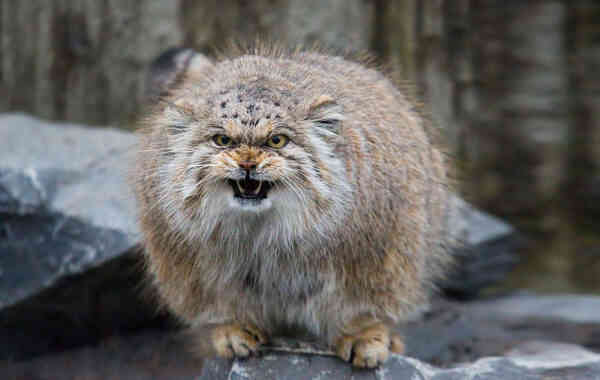These severe wild cats, manuls, at the beginning of the 21st century became insanely popular on the Internet, as it seemed to many that they are very cute. In fact, these representatives of the cat family really look very funny, but they cannot be tamed, and in the wild it is better not to approach them, unless, of course, you have a desire to immediately go to the hospital to get stitches and injections.
Interesting facts about the manul
- Sometimes it is also called the “Pallas cat”, in honor of the naturalist Pallas, who was the first to describe the habits and habits of this animal.
- Because of the dense and thick wool, the manul seems larger than it is. In fact, it is comparable in size to an ordinary domestic cat. So, the weight of an adult manul usually ranges from 2.5 to 5 kg (interesting facts about cats).
- Manuls also live in the mountains, meeting at an altitude of up to 4.5-4.8 kilometers above sea level, where atmospheric pressure is only about half of the norm.
- In length, manul wool can reach almost 8 centimeters.
- This predator has up to 9000 hairs per square centimeter of the body.
- In addition to Russia, manuls are found on the territory of Mongolia, China and several other countries.
- In captivity, they almost always fall into apathy and refuse to breed.
- Pallas’s fur is thicker than any other feline, including snow leopards (interesting facts about snow leopards).
- They usually live in burrows where they hide during the daytime. They go out to hunt at night.
- Despite their inherent curiosity, manuls usually stay away from people and their settlements.
- The maximum speed that a manul can develop when running is lower than that of all other representatives of the cat family.
- The menu of this predator is based on small rodents and birds. In times of famine, manul does not disdain insects.
- Manuls breed only once a year, and the male does not take part in raising offspring, disappearing shortly after mating.
- During the mating season, male manuls often arrange violent fights over females.
- Manuls are not tamed at all. Even in zoos, they perceive their territory as their own, and often attack workers when they go inside.
- Manul kittens begin to hunt independently at the age of 3.5-4 months.
- Over the past decades, the population of manuls has been catastrophically reduced due to human activity.
- This predator usually builds a lair for itself in crevices of rocks or under the roots of trees, but on occasion it willingly occupies ownerless burrows of other animals.
- When meeting a dangerous enemy, the manul usually tries to hide unnoticed. If he does not succeed, he enters the battle. Despite its compact size, this wild code is a formidable adversary.
- The length of a manul’s tail can be up to 50% of its body length.
- In the wild, these animals avoid the company of relatives, meeting with them only during the breeding season.
- The tips of the hairs of the Pallas’ cat are almost white, which makes their coat look so silvery.
- In relation to the proportions of the body, the paws of the Pallas’ cat are one of the shortest in the world when compared to other cats.
- One adult manul occupies an area of up to 8-10 square kilometers. They avoid invading the hunting grounds of their relatives.
- There have been cases when manuls successfully hunted even animals comparable in size to them, for example, hares.
- Manulas are listed in the international Red Book as an endangered species.
- Hunting these animals is prohibited in all countries where they are found.
- Scientists have established that manuls as a species appeared about 12 million years ago.
- Thanks to its impressive fur coat, the manul is able to endure frosts down to -50 degrees without harm to itself.
- Unlike domestic cats, the pupils of the manul do not change depending on the lighting, always remaining the same size.
